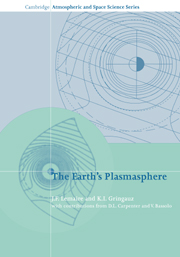Book contents
- Frontmatter
- Contents
- Preface
- Foreword
- Dedication
- Introduction
- Chapter 1 Discovery of the plasmasphere and initial studies of its properties
- Chapter 2 Electromagnetic sounding of the plasmasphere
- Chapter 3 Plasmasphere measurements from spacecraft
- Chapter 4 A global description of the plasmasphere
- Chapter 5 Theoretical aspects related to the plasmasphere
- Epilogue
- References
- Index
Chapter 3 - Plasmasphere measurements from spacecraft
Published online by Cambridge University Press: 24 November 2009
- Frontmatter
- Contents
- Preface
- Foreword
- Dedication
- Introduction
- Chapter 1 Discovery of the plasmasphere and initial studies of its properties
- Chapter 2 Electromagnetic sounding of the plasmasphere
- Chapter 3 Plasmasphere measurements from spacecraft
- Chapter 4 A global description of the plasmasphere
- Chapter 5 Theoretical aspects related to the plasmasphere
- Epilogue
- References
- Index
Summary
Introduction
Preliminary remarks
Besides whistler observations, direct particle measurements from spacecraft (especially from satellites with highly elliptical and geostationary orbits) have contributed significantly to our understanding of the plasmasphere and of its outer boundary, the plasmapause. In particular, such measurements permit us to investigate a number of topics that are not subject to direct observation by radio techniques, including low-energy ion composition, pitch angle distribution, and temperature.
Satellite instruments which have contributed to plasmaspheric studies involve both direct particle flux measurements as well as wave observations. We have already reported in Chapter 2 some results from wave experiments, and in the present chapter will discuss such observations only when they appear to be complementary to direct plasma measurements. Most of our attention will be focused on direct particle measurements, obtained with Langmuir probes, charged particle traps, retarding potential analyzers (RPA), and ion mass spectrometers of different types.
Several problems are inherent in measurements made with the above-mentioned devices. The most serious problems arise when the instruments operate in a very low-density plasma and/or when the energy of the measured particles is very low. Indeed, it is difficult in practice to eliminate all the factors distorting the direct measurements, in spite of the care taken by their developers, including extensive preflight tests and calibration.
- Type
- Chapter
- Information
- The Earth's Plasmasphere , pp. 108 - 158Publisher: Cambridge University PressPrint publication year: 1998



